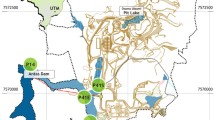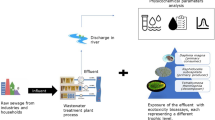Abstract
The lethal and sublethal toxicity of effluent from three acid mine drainage treatment plants were monitored from August 2009 to April 2010 using Daphnia magna (reference species) and Moina macrocopa (indigenous species). Acute lethal toxicity was observed in Samma effluent due to incomplete neutralization of acid mine drainages by the successive alkalinity producing system (SAPS). Additionally, there was no significant difference in toxicity values (TU) between D. magna and M. macrocopa (p < 0.05). Toxicity identification results of the final effluent collected in January 2010 showed that Al and Zn were key toxicants in addition to acidic pH. Unlike the Samma effluent, both Hwangji and Hamtae effluent had pH values that were near neutrality and showed either no acute toxicity or toxicity values less than 1 TU. However, the feeding rates of D. magna and M. macrocopa were significantly reduced when compared to the control (p < 0.05). These findings suggest that the Hamtae and Hwangji effluent likely have a sublethal effect on aquatic organisms in receiving water bodies.




Similar content being viewed by others
References
Allen Y, Calow P, Baird DJ (1995) A mechanistic model of contaminant-induces feeding inhibition in Daphnia magna. Environ Toxicol Chem 14:1625–1630
APHA (American Public Health Association) (1998) Standard methods for the examination of water and wastewater, 20th edn. Washington, DC
Barata C, Alañon P, Gutierrez-Alonso S, Riva MC, Fernández C, Tarazona JV (2008) A Daphnia magna feeding bioassay as a cost effective and ecological relevant sublethal toxicity test for environmental risk assessment of toxic effluents. Sci Total Environ 405:78–86
Cherry DS, Currie RJ, Soucek DJ, Latimer HA, Trent GC (2001) An integrative assessment of a watershed impacted by abandoned mined land discharges. Environ Pollut 111:377–388
Denicola DM, Stapleton MG (2002) Impact of acid mine drainage in benthic communities in stream: the relative roles of substratum vs. aqueous effects. Environ Pollut 119:303–315
Gauld T (1951) The grazing rate of marine copepod. J Mar Biol Assoc 26:695–706
Gerhardt A, Bisthoven LJD, Soares AMVM (2005) Evidence for the stepwise stress model: Gambusia holbrooki and Daphnia magna under acid mine drainage and acidified waater stress. Environ Sci Technol 39:4150–4158
Hamoda MF, Al-Ghusain I, Al-Mutairi NZ (2004) Sand filtration of wastewater for tertiary treatment and water reuse. Desalination 164:203–211
Heinlaan M, Ivask A, Blinova I, Dubourguier HC, Kahru A (2008) Toxicity of nanosized and bulk ZnO, CuO, and TiO2 to bacteria Vibrio fischeri and crustaceans Daphnia magna and Thamnocephalus platyurus. Chemosphere 71:1308–1316
Ji K, Kim Y, Oh S, Ahn B, Jo H, Choi K (2008) Toxicity of perfluorooctane sulfonic acid and perfluorooctanoic acid on freshwater macroinvertebrates (Daphnia magna and Moina macrocopa) and fish (Oryzias latipes). Environ Toxicol Chem 27:2159–2168
Johnson DB, Hallberg KB (2005) Acid mine drainage remediation options: a review. Sci Total Environ 338:3–14
Karamalidis AK, Voudrias EA (2007) Release of Zn, Ni, Cu, SO4 2- and CrO4 2− as a function of pH from cement-based stabilized/solidified refinery oily sludge ans ash from incineration of oily sludge. J Hazard Mater 141:591–606
Macedo-Sousa JA, Pestana JLT, António AG, Nogueira JA, Soares AMVM (2007) Behavioural and feeding responses of Echinogammarus meridionalis (Crustacea, Amphipoda) to acid mine drainage. Chemosphere 67:1663–1670
Maltby L, Crane M (1994) Responses of Gammarus pulex (amphipoda, crustacean) to metalliferous effluents: identification of toxic conponents and the importance of interpopulation variation. Environ Pollut 84:45–52
Matthies R, Aplin AC, Jarvis AP (2010) Performance of a passive treatment system for net-acidic coal mine drainage over five years of operation. Sci Total Environ 408:4877–4885
Matus P, Kubova J (2005) Complexation of labile aluminium species by chelating resins Iontosorb-a new method for Al environmental risk assessment. J Inorg Biochem 99:1769–1778
McLoughlin N, Yin D, Maltby L, Wood RM, Yu H (2000) Evaluation of sensitivity and specificity of two crustacean biochemical biomarkers. Environ Toxicol Chem 19:2085–2092
Neculita C, Vigneault B, Zagury GJ (2008) Toxicity and metal speciation in acid mine drainage treated by passive bioreactors. Environ Toxicol Chem 27:1659–1667
OECD (2004) Daphnia sp. Acute immobilization test. OECD guidelines for testing of chemicals no. 202, Paris, France
Pagnanelli F, Michelis ID, Muzio SD, Ferella F, Vegliò F (2008) Bioassessment of a combined chemical-biological treatment for synthetic acid mine drainage. J Hazard Mater 159:567–573
Pestana JLT, Re A, Nogueira AA, Soares AMVM (2007) Effects of cadmium and zinc on the feeding behaviour of two freshwater crustaceans: Atyaephyra desmarestii (Decapoda) and Echinogammarus meridionalis (AMphipoda). Chemosphere 68:1556–1562
Skousen J (1997) Overview of passive systems for treating acid mine drainage. Green Lands 27:34–43
Strigul N, Vaccari L, Galdun C, Wanze M, Liu X, Christodoulatos C, Jasinkiewicz K (2009) Acute toxicity of boron, titanium dioxide, and aluminum nanoparticles to Daphnia magna and Vibrio Fischeri. Desalination 248:771–782
USEPA (1991) Methods for aquatic toxicity identification evaluations: phase I. Toxicity characterization procedures. EPA 600/6-91/003, Washington DC
USEPA (1993a) Methods for aquatic toxicity identifications evaluations: phase II. Toxicity identification procedures for samples exhibiting acute and chronic toxicity. EPA/600/R-92/080, Washington DC
USEPA (1993b) Methods for aquatic toxicity identifications evaluations: phase III. Toxicity confirmation procedures for samples exhibiting acute and chronic toxicity. EPA/600/R-92/081, Washington DC
USEPA (2002) Methods for measuring the acute toxicity of effluents and receiving waters to freshwater and marine organisms. EPA/821/R-02/012, Washington DC
Yi X, Kang SW, Jung J (2010) Long-term evaluation of lethal and sublethal toxicity of industrial effluents using Daphnia magna and Moina macrocopa. J Hazard Mater 178:982–987
Yim JH, Kim KW, Kim SD (2006) Effect of hardness on acute toxicity of metal mixtures using Daphnia magna: Prediction of acid mine drainage toxicity. J Hazard Mater B138:16–21
Acknowledgments
This work was supported by Mine Reclamation Corporation of Korea and National Research Foundation of Korea Grant funded by the Korean Government (KRF-2008-313-D00541).
Author information
Authors and Affiliations
Corresponding author
Rights and permissions
About this article
Cite this article
Seo, J., Kang, SW., Ji, W. et al. Potential Risks of Effluent from Acid Mine Drainage Treatment Plants at Abandoned Coal Mines. Bull Environ Contam Toxicol 88, 990–996 (2012). https://doi.org/10.1007/s00128-012-0592-0
Received:
Accepted:
Published:
Issue Date:
DOI: https://doi.org/10.1007/s00128-012-0592-0




